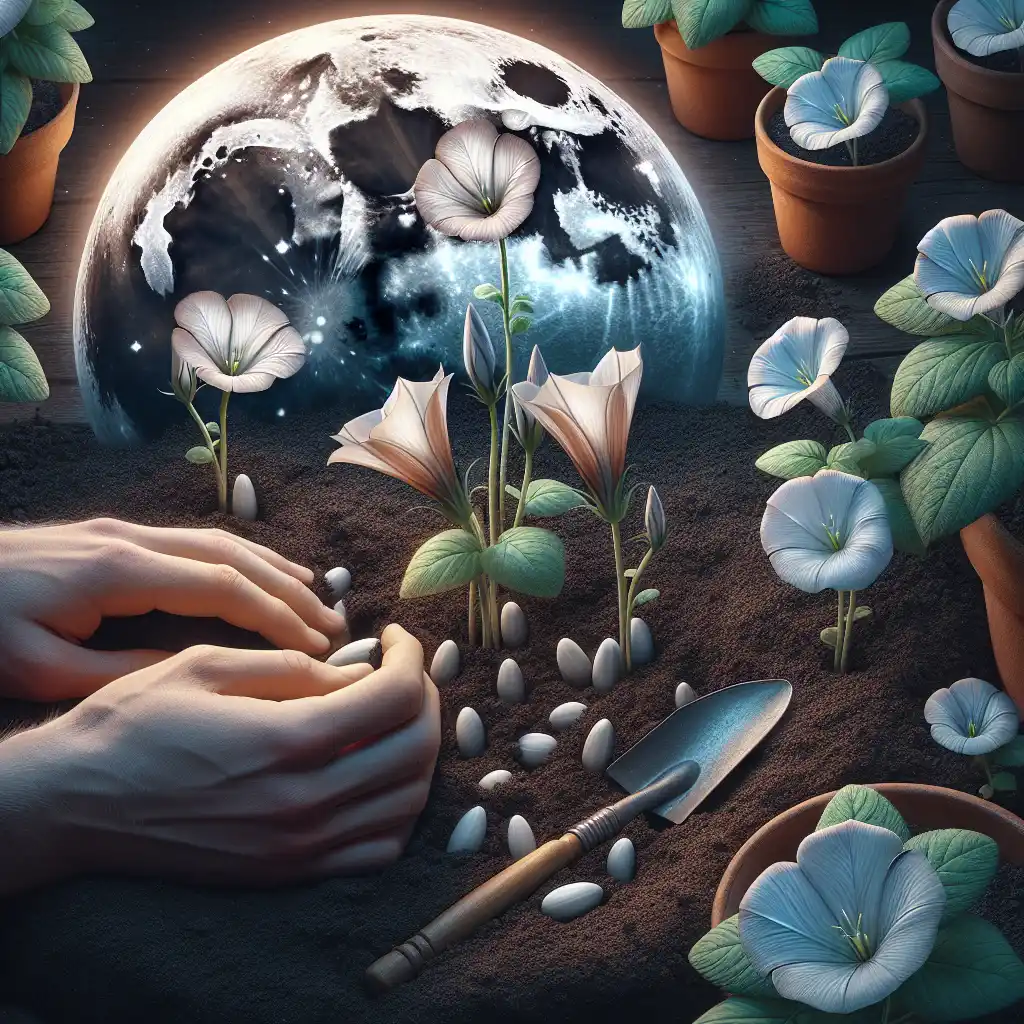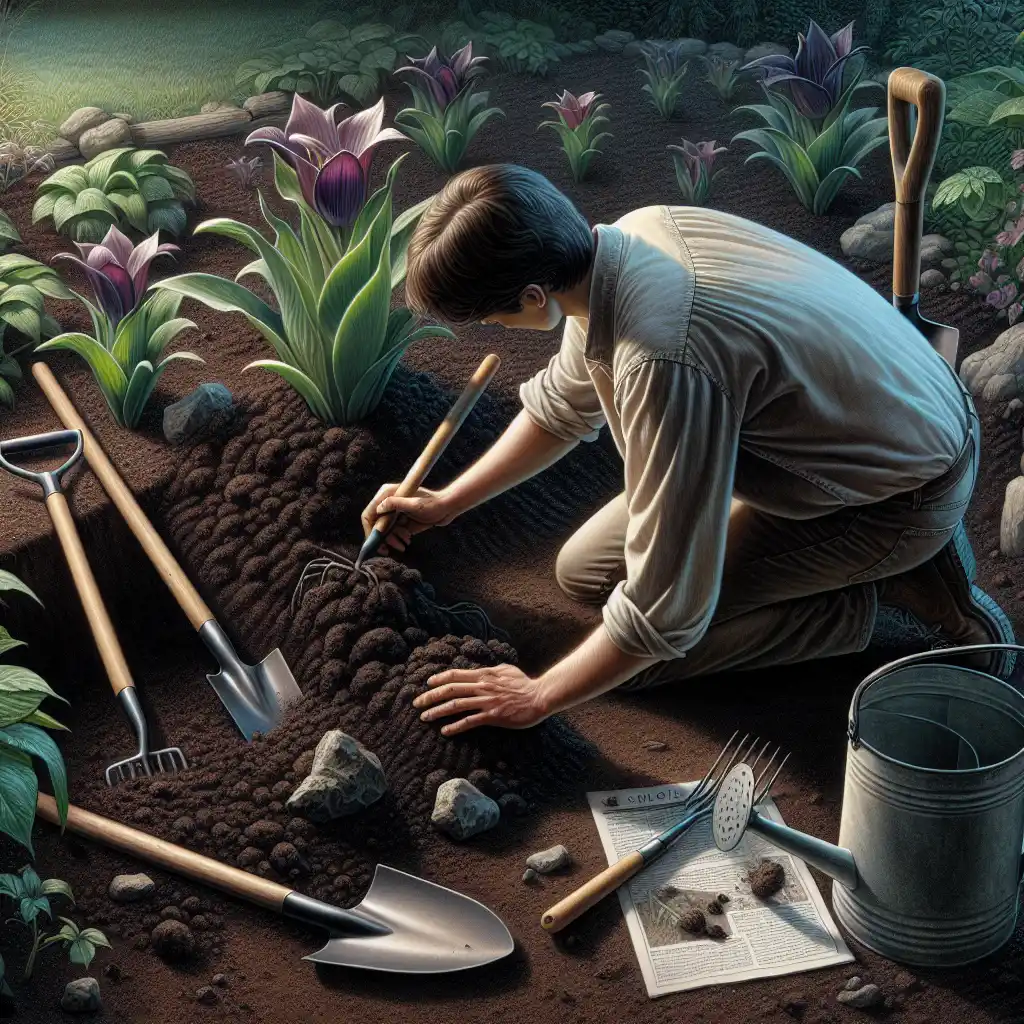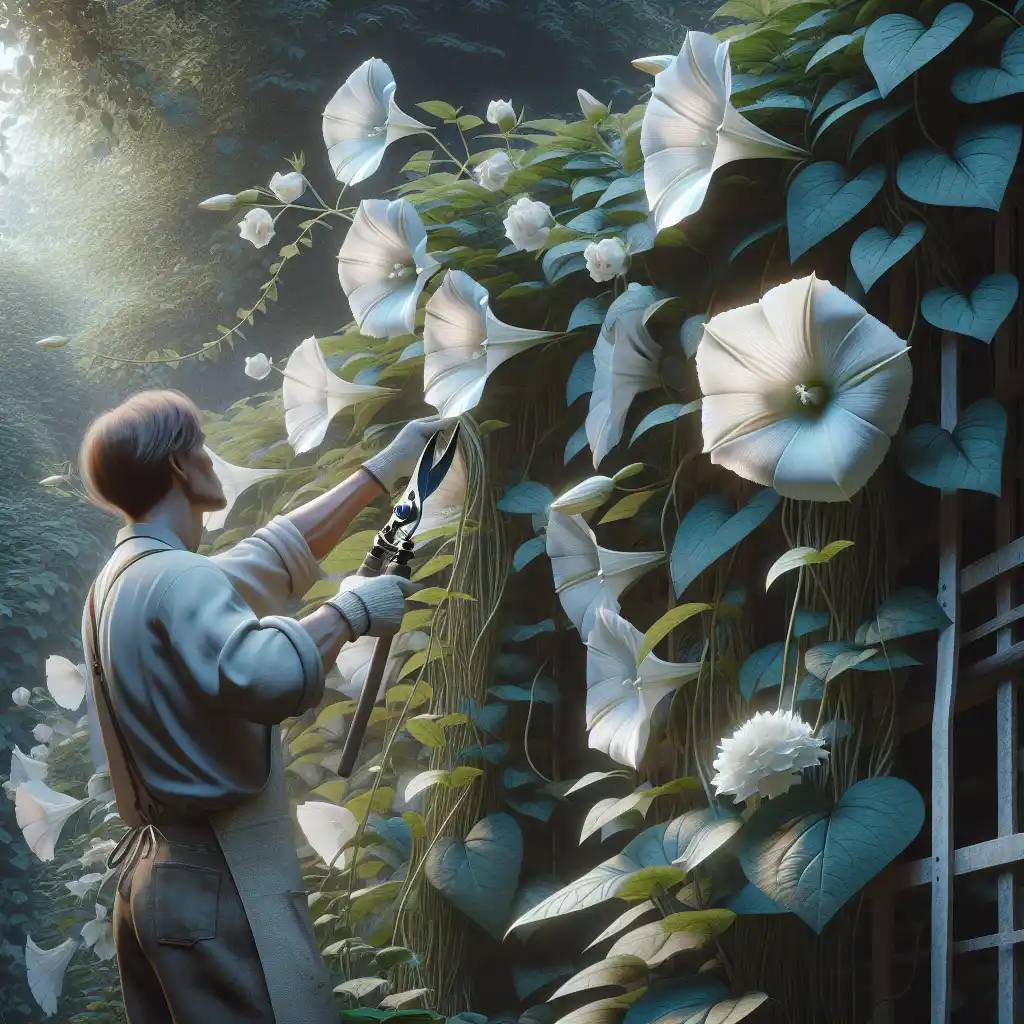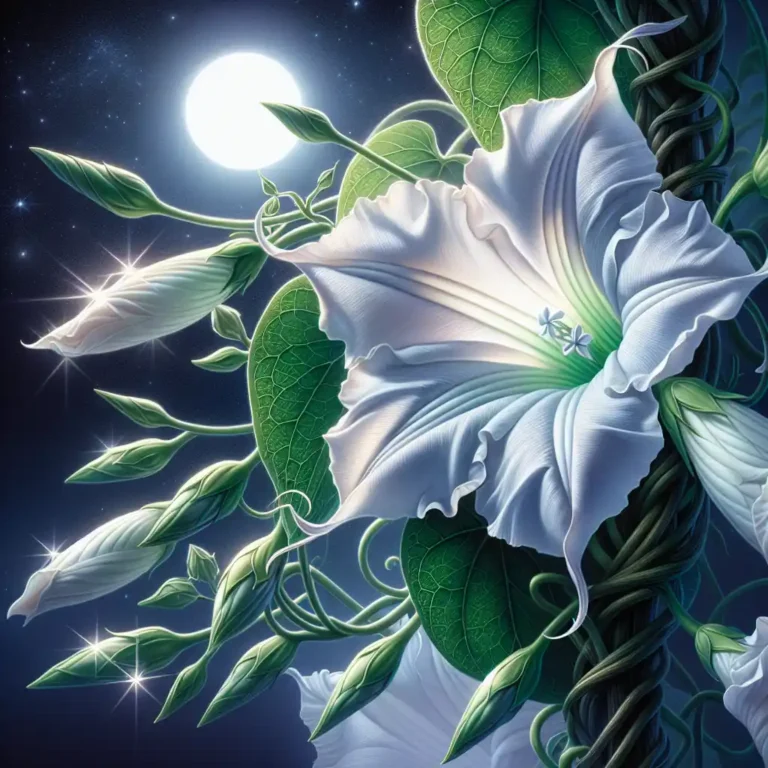Under the cloak of night, a blossom unfurls with ethereal charm, releasing a perfume that dances on the moonlit breeze. Behold the Moon flower, nature’s ode to the celestial—a fragrant vine that captivates gardeners and night owls alike. Cradle of dreams, this nocturnal beauty thrives under the stars, a luminous spectacle in the quiet of the evening garden. Let us embark on a journey to unlock the secrets of cultivating these radiant blooms, where moonlight and fragrance interlace in a timeless waltz. Embrace the allure of the Moon flowers and prepare to transform your nocturnal garden space into an enchanting floral paradise.
Overview of the Moon flower
Imagine the sun has dipped below the horizon, and the world is clothed in the velvety cloak of twilight. Then, as if by magic, the night sky unfurls its stars, and the Moon flower, a stately plant as enchanting as its celestial namesake, opens its large, trumpet-shaped flowers to embrace the night. The Moon flower, known scientifically as Ipomoea alba, is an exotic, nocturnal-blooming vine that captivates all who witness its brief but wondrous display. As darkness falls, its huge, 6-8 inch diameter, pure-white blossoms unfurl with a heavy, intoxicating fragrance, turning any flower garden into a mystical realm.
These striking plants, members of the Morning Glory family, hail from the lush landscapes of Central America. They are climbers extraordinaire, capable of ascending up to 15-20 feet in a single season, gracing trellises, fences, and walls with their elegant drapery. Moon flowers are adaptable creatures, thriving under the golden kiss of the full sun, yet content to bloom in the subtle embrace of partial shade. While common plants shy away as daylight fades, the nocturnal Moon flower bursts into life, its blooms exploding into the night, drawing to itself the secret keepers of the dusk – the moths and bats, which revel in its sweet nectar.
But these are not fussy plants; rather, they are the brave souls of the flower garden, strong and wildhearted. Yet, they do have their quirks. Their seeds, protected by a tough exterior, must be soaked and nicked to sprout, presenting a delightful challenge to gardeners dreaming of those enchanting evening blooms. Paired with gray-green leaves that bring a tropical flair to the landscape, the Moonflower is undeniably alluring, a mesmerizing addition to any botanical collection.
What is a Moon flower?
A Moonflower is a vision of nighttime elegance. As a vining plant, it spirals upwards with vigor, seeking height and space to display its wondrous, large, 5-foot-tall white blossoms that unfurl as dusk settles. Part of the Morning Glory family yet distinct in its nocturnal habits, the Moon flower distinguishes itself with each of its blooms lasting a single night. Its native environment in Central America paints a picture of synergy, with its vines often entwined with the trunks of the Panama Rubber Tree, contributing to the age-old tradition of rubber-making via its sap.
The extraordinary nature of the Moonflower is not merely in its blooms but in its history and utility. Touching upon the roots of Central American culture, the legacy of the Moon flower stretches back to the Olmecs, ancient people who understood and harnessed the power of the plant’s vulcanizing capabilities to create objects essential to their way of life, including the rubber balls used in their ceremonial games.
Key Features and Benefits of Moonflowers
The Moon flower may seem like an ethereal apparition of the night, but it is, in fact, a tangible, wonderful plant that brings numerous features and benefits to the garden. Its blooms, opening only at dusk and fading at dawn, are nature’s own nighttime light show. The white blossoms, spanning an impressive eight inches, transform the nocturnal garden into a landscape of lunar splendor, captivating any onlooker with their radiant glow.
The plant’s sizable, attractive leaves add to its charisma, creating a backdrop that accentuates the brilliance of the blooms. For those seeking to evoke a sense of romance and the mysterious, the Moonflower is your botanical muse. This self-seeding marvel not only brings beauty but also serves as an eco-friendly agent, attracting and sustaining the delicate ecosystem of nighttime pollinators.
Moon flowers produce a romantic and mysterious atmosphere, their scent wafting through the evening air, and their presence is a reminder of nature’s untamed grace. With their impressive size, striking presence, and their fragrant, gray-green leaves, Moon flowers establish themselves not only as gorgeous exhibitions of floral architecture but also as horticultural treasures that keep the garden alive, even in the quiet of night.

Planting Moon flowers
Immersing oneself in the art of gardening with moon flowers, known scientifically as Ipomoea alba, begins with a heartfelt selection of the perfect enclave for their night-time majesty. These celestial climbers, descendants of Central America’s lush realms, cherish warmth and ample drainage to unveil their mysterious nocturnal ballet. Embrace the wisdom of the ancients, and place these ethereal beings in sunny corners with fertile, loamy embrace – though be assured, they are forgiving sprites, willing to accommodate various soils, as long as they can rest their roots away from stagnating waters.
A word of caution to the guardians of this sacred garden: moonflowers, with all their bewitching charm, possess a dark secret. Their beauty is not to be tasted, as it harbors a fatal poison. Secure them beyond the innocent reach of curious children and pets. And remember, like enchanted vines in lore, they may strive to conquer far and wide. Prevent their zealous spread by removing their seed pods, keeping their spirits bound to your chosen haven, and the magic of their fragrance a treasured delight for those who venture near your nocturnal oasis.
| Choosing the Sacred Spot | |
|---|---|
| USDA Hardiness Zones | Ideal in 3-9 for evening fragrance |
| Safety | Position out of reach; toxic if eaten |
| Growth Habit | Can be aggressive; manage to prevent spread |
| Environmental Condition | Warmth and good drainage are paramount |
| Soil Preference | Fertile, loamy soil; tolerant of variations |
Preparing the Soil for Moonflowers
When the earth begins to warm under the summer stars, it is time to awaken seeds that will bloom beneath the moon’s glow. To cultivate the soul-soothing essence of Ipomoea alba, patience and preparation of the soil are as crucial as the spells of old. Like a secret rite, score their hardy seeds, and bathe them in water for a full day’s cycle to hasten their awakening. Plant them in soil that craves the caress of water yet spurns its lingering presence.
Grace your moonflowers with a blanket of mulch, maintaining the moist but not drenched earth they adore. Test the soil as you would test the waters of a mystic lake, with a gentle touch of a finger. Should the earthen well be dry beyond the realm of your first knuckle—heed the call to water these nocturnal nymphs.
Proper Planting Techniques
With the return of warmth to the earth, a ballet begins in the soil—a delicate dance of moonflower planting. The seeds, once scored and bathed, yearn for their earthen bed. Bury them shallow, just half an inch deep, a mere six inches apart to offer room for their twilight twirls. If your heart seeks to summon them within the confines of containers, the enchantment calls for three to share a pot of no less than ten inches—a trinity to thrive in their circumscribed cosmos.
Be vigilant, for their coats are as tough as the stories of the moon; a gentle abrasion with a nail file or a prolonged soak may ease their passage into this realm. Grant them this tenderness, and they shall reward you with their siren’s call and silvery radiance.
Watering and Sunlight Requirements
Moon flowers, in their stately grace, ask for a delicate balance of Helios’s gaze and the reprieve of the shade—an alchemy of sunlight conditions that feeds their majesty. Sow them in soil that drains as swiftly as it welcomes the rain, for their roots abhor the suffocation of waterlogged soil. Water them with the reverence of an ancient ritual, ensuring the earth is moist—an offering to sustain them, but never to drown.
The light of the sun and the shadow play a dance that nourishes these nocturnal bloomers. Offer them this stage of sun to partial shade, and watch as they unfurl in their grandeur, a testament to the loving care and respect paid to their elemental needs.
Choosing the Right Location for Planting
Embrace the ethereal beauty of the Moon Flower, a nocturnal miracle that unfurls its white blossoms against the canvas of the night. As a passionate botanist or an enchanted gardener, to behold the large, trumpet-shaped flowers illuminating your space, it’s essential to plant your moonflower, Ipomoea alba, in its ideal habitat.
Zone Compatibility:
Ensure your Moon Flowers bask in the perfect climate, ideally within USDA Hardiness Zones 3–9, allowing them to thrive and share their evening fragrance.
Safety First:
Moonflowers are indeed a striking sight, but their allure harbors a deadly secret if ingested. Always plant them out of the curious hands and paws of children and pets.
Growth Management:
Beware of their weedy nature; these enchanting plants can turn into aggressive spreaders. Prevent a garden takeover; remove seed pods diligently.
Location, Location, Location:
Seek warmth and excellent drainage for optimum blooming. Moon flowers desire the sun’s kiss in the day to blossom at night. Choose sunny locations with fertile, loamy soil, although they can adapt to various soil conditions given adequate drainage.
By honoring these guidelines, your Moon Flower, an exotic and wonderful plant, will stand as a stately presence, casting pure-white reflections and a nocturnal aroma, turning your flower garden into a moonlit sanctuary.
Care Tips for Optimal Growth
To unlock the full potential of the wonderful moon flower, Ipomoea alba, and capture the awe of its nocturnal display, proper care and cultivation are vital. These stately plants flourish upon both the open arms of the sun and the sheltering embrace of partial shade, offering their white blossoms as a tribute to balanced elements. Soil, the nurturing foundation, should cradle the roots in neutrality, neither acidic nor alkaline, and with the power of impeccable drainage.
In the dance of life, they revel in adequate moisture to thrive, a refreshing sip of life’s essence without the despair of soggy feet. Beware, for such waterlogged sorrow may beckon the plight of rot—a cruel fate for such a majestic entity. For best results, plant these striking plants in locations free from the last whispers of frost’s caress, be it upon the open stages of your gardens or within the cozy confines of containers, where their resilience to confrontation with cold is yet untested.

Fertilizing Moonflowers
Prepare to be enchanted by the moonflower’s response to replenishment through the seasons as you bestow upon it the gift of sustenance. Embrace a high-phosphorus fertilizer such as bone meal, a potion no less magical than fairy dust, to coax your five-inch-wide flowers into luminous bloom. Administer this feed moderately, at half the might of its full strength, to boost the flora without overwhelming its delicate constitution.
Regular fertilization during the galaxy of its blooming season will ensure the bounty of their pure-white trumpets and entice the music of the night, from the hums of moths to the whispers of bats, drawn to the sweet melodies of its scent.
Pruning and Training Moonflowers
Prune with the tender care of an artist, employing the simplest of tools—an unassuming pair of nail clippers—to gently guide the awakening of the seed, having bathed them in the waters of germination. Show your love for these exotic plants by helping them ascend, creating living tapestries on trellises, pergolas, or any structure that yearns for the kiss of drama and spectacle. These vining plants crave not just earth but sky, seeking to climb towards the stars from whence they draw their namesake.
Those who dare to train such a shrubby-looking plant will be rewarded with a luscious, scented privacy screen, a verdant barrier against the mundanity of the world, adorned with the nocturnal blossoms that evoke the beauty of a world adrift in twilight.
Mulching and Weed Control
The act of mulching is akin to tucking your precious moonflowers into bed, a blanket that ensures the retention of moisture, a bulwark against the drying winds and scorching days. It is a humble guardian that not only maintains the sedate temperatures they cherish but also holds back the insidious advance of weeds, those common plants that would usurp the nutrients deserved by your exotic blooms.
In the realms of these striking plants, mulch is an ally, a companion in the pursuit of beauty, helping these nocturnal-blooming troubadours to focus their energies on the production of their radiant balls of flowers without the distraction and rivalry of unwanted green interlopers.
Dealing with Common Pests and Problems
Moonflowers, as stately as they are in the moonbeams’ glow, do not sail these nocturnal seas unchallenged. Marauders such as whiteflies, spider mites, and mealybugs may besiege them, seeking to sully their striking beauty. A valiant spray of water can be a simple yet effective shield against such assaults, banishing these pests with a force as natural as rain.
When the siege is relentless, turn to the botanical armaments of neem oil or insecticidal soap, and watch your plants find sanctuary once more. Mind the soil’s disposition, for the great adversary is root rot, lurking in the damp. Ensure the ground is well-aired and content in its drainage.
Nocturnal guardians and lovers of natural grace, take heed—for your moonflowers are a joy to behold but a woe to taste. Like the bewitching dangers of a zombie plant, their alluring visage masks a toxic truth. Hedge your bets on care, and not consumption, and let the lunar splendor of the moonflower illuminate your gardens with its nightly serenade.

Propagating Moonflowers
Embrace the elegant dance of propagation with the ethereal Moonflower, a nocturnal wonder that captivates the senses and graces the night with its large, trumpet-shaped flowers. This vining plant, a member of the exotic Ipomoea alba species, is not only a striking addition to any garden but also a symbol of mystery and intrigue, unfurling its white blossoms as dusk falls to herald the arrival of night’s enchanting embrace.
When nurturing Moonflowers, you must understand the artistry involved in their propagation. Coaxing the sleepy seeds to life requires patience and delicate care. These seeds, encased in a protective hard coating, benefit from being gently nicked with a nail file or bathed in a 24-hour soak, a technique that whispers the promise of new life by aiding in germination. Once awakened, they long for the warmth of late spring or early summer soil to begin their journey to the stars.
Whether you drape them over large containers, trellises, or pergolas, three plants per 10-inch pot is the harmonious arrangement for these captivating nocturnal souls. This trinity will flourish, exploring vertical heights and crafting a floral tapestry under the moon’s soft glow, transforming your urban or rural setting into a midnight garden replete with the sweet scent that beckons to the secretive nocturnal pollinators—the moths and bats that dance through the shadowy air.
Moon flowers thrive in the embrace of warmth; these tropical plants are shy of the cold, requiring the caress of tepid breezes and sun-kissed climes to truly flourish. In climates less clement, they somberly refuse to grow, yearning instead for tropical or subtropical warmth where they can stretch and bloom unencumbered.
Seed Collection and Storage
The journey of the Moon flower begins long before it reaches for the night sky. To ensure that your flower garden becomes a sanctuary for these dramatic spider flowers—five-inch-wide emissaries of the night—you must first harvest their seeds with a foresight that rivals the wisdom of the ancients. Scoring and soaking the seeds for 24 hours sets the stage for a bountiful germination, encouraging the future blossoms to unfurl with vigor and vitality.
As container plants, Moon flowers exhibit a serene elegance, three plants nestled within a 10-inch pot becoming a symphony of potential delicate blooms. You can commence their life cycle indoors, four to six weeks before the last frost kisses the ground farewell, or wait for the season to warm the earth in regions that smile with the sun’s affection. Regardless of the method, remember that the loamy, fertile soil they yearn for must offer the sweet respite of adequate drainage.
Moon flowers are not merely plants; they are the artisans of the natural world, capable of creating scented privacy screens when twined along lattice or trellis supports. Their alluring secrecy is a canvas, waiting for you to paint with their seeds—the genesis of fragrant masterpieces that tantalize the senses and offer reprieve from the mundane.
Germinating Moon flower Seeds
Within each Moon flower seed lies a heart beating with the promise of nocturnal beauty. The ritual of scoring and soaking is a testament to your dedication to nurturing these seeds to fruition, a commitment that will be rewarded by the silent unfurling of petals against the canvas of the night. As with all things of delicate beauty, patience and care are your trusted allies.
Planting three Moonflowers to a 10-inch pot honors the sacred geometry of growth, ensuring that each plant has the room to stretch and entwine with its companions, a trinity of elegance in your garden. The timing of their emergence from the soil is a careful orchestration—late spring to early summer—when the soil has shed its winter chill and dons the warmth essential for germination.
In many cultures, Moonflowers symbolize a deeper meaning—mystery, love, and spiritual enlightenment. As part of the Ipomoea genus, they are safe to touch but demand respect, for their grace is matched by a mild toxicity if ingested—a warning to admire from afar, to cherish without the folly of consumption.
Transplanting Moonflower Seedlings
The infancy of Moonflower seedlings is a delicate period, a time when they must acclimate to the world outside their nurturing cradle. This hardening off process, spanning a meticulous 7 to 10 days, is the prelude to transplanting, the moment when they first feel the earth beneath their roots outside of their initial confines. With gentle care, seeds planted a modest ¼ inch deep in individual cells or small pots are ready to make their debut in the grand theater of the garden.
Preparing the stage is crucial—a bed enriched with the bounty of compost welcomes the tender seedlings, ensuring that their new home is rich and ready for the miracles they will perform under the moon’s watchful eye. For those who prefer to witness the birth of their Moonflowers directly from the earth, a gentle sowing 1/2 inch deep, with seeds spaced a breath—four inches—apart, will suffice.
The erecting of a trellis or arbor at the time of direct sowing or transplanting is an act of foresight. These Moonflowers will need support as they climb toward the heavens, their roots vulnerable to disturbance. Offer them this foundation, and in return, they will ascend, transforming your space into a nocturnal paradise, a sacred place where Moonflowers rule the night with their silent, perfumed majesty.
Different Types of Moonflowers
The moon flower, a name that paints a picture of nightfall elegance and nocturnal mystery, graces this world with two primary personas. The first, Datura stramonium, commonly known as devil’s trumpet, jimson weed, or loco weed, unfurls its bloom with the touch of day, contrary to what its name might suggest. Residing low to the ground, this plant offers a distinctly shaped flower, different from its night-blooming counterpart.
Enter the enchanting realm of Ipomoea alba, also recognized as the true moonvine. This is where the moonflower truly earns its name as a nocturnal-blooming plant, producing fragrant white flowers that wait for the curtain of dusk to unveil their splendor. As the night unwinds, these delicate flowers of the Ipomoea genus slowly unravel their petals, only to retire into a gentle curl with the morning’s first light.
Our gardens are not confined to just the singular purity of white; varieties like the ‘Blackcurrant Swirl’ and ‘Evening Fragrance’ offer a symphony of colors and sizes, from balls of five-inch-wide flowers to shades that evoke the dramatic spider flower. These flowers are not merely striking plants; they are storytellers that whisper tales of nocturnal life and the beauty that thrives beneath the moon’s gentle gaze.
Introduction to Popular Varieties
The awe-inspiring Moon flower Datura spp., with its stately, large, trumpet-shaped flowers, weaves a magical spell as it unfurls in the evening air, filling the surroundings with a hint of lemon fragrance. These are not the shy, demure blooms that nestle in obscurity; instead, they announce their presence with a boldness that rivals the very celestial body they’re named after.
It’s easy to mistake one moon flower for another, as this common name is shared between the distinct Datura stramonium and the enchanting Ipomoea alba. Each bears its character like a badge of distinction; each thrives with different whims, yet both find solace in the warmth of a Southern climate, adorning the timespan from September to October with their bloom — especially noted in Western North Carolina’s flowering calendars.
These vining marvels command a soil rich in the spoils of life – fertile, loamy, and capably drained. Whether you wish for these earthly stars to adorn your spacious containers or to morph your trellises into living privacy screens, they’ll meet your desires with a graceful ascent into the heavens.
Growing Specific Moonflower Species
To court favor with moonflowers, timing is as essential as tenderness. Plant them in the embrace of late spring or the passion of early summer, when the soil basks in warmth. Immerse their seeds in a 24-hour soak, a ritual that hastens the awakening of life and promises an expedited meeting with their ethereal blooms.
The soil that moon flowers call home need not be uniform, for they are adaptable creatures that can flourish in containers or the earth, as long as the foundation is fertile, loamy, and ensures the departure of excess water. Treat them to the nutrients of compost and the maturity of aged manure, and these vining plants will scale your trellis with a vigour that turns heads and captures hearts.
Whether you seek to sow their beginnings indoors, a preparatory step 4 to 6 weeks before the frost bids farewell, or directly in the welcoming ground of warmer terrains, moon flowers are gifted with the touch of resilience, reseeding themselves and ensuring their legacy. Then there’s the moonflower vine – a testament to the beauty in thorns, sprouting pods as it stretches up to an elegant 16 feet, vowing to leave behind the shrubby appearance for a length that writes its narrative across the skies.
Introduction to Popular Varieties
Embark on a magical journey as we introduce you to the ethereal world of Moonflowers, enchanting nocturnal plants that cast a spell over gardens with their otherworldly glow. Imagine the state of sublime serenity as these lunar darlings, with their large, trumpet-shaped flowers, unfurl at dusk with a celestial lemon scent, heralding the night in moonlit splendor.
| Common Name | Scientific Name | Characteristics | Flowering Season | Preferred Environment |
|---|---|---|---|---|
| Moon flower | Datura spp. | Dramatic, large, trumpet-shaped pure-white or purple flowers | September to October in NC | Fertile, well-drained loamy soil, partial shade to full sun |
| Moonflower Vine | Ipomoea alba | Delicate, intoxicating white blossoms that open at night | Warm summer months | Fertile, moist soil, full sun to partial shade |
Datura stramonium and Ipomoea alba, commonly mistaken as one, are truly distinct marvels. While the former boasts a more shrubby demeanor, Ipomoea alba exudes elegance with its vining grace. These 5-foot-tall plants can elevate the aesthetics of any space, be it contained in large containers for urban balconies or sprawling on trellises for majestic privacy screens. Bathed in moonlight, these blossoms create an enchanting tableau that can easily be the centerpiece of every flower garden.
Growing Specific Moonflower Species
Embrace the enchanting allure of the Moon Flower, a spectacular addition to any flower garden. Delight in the majesty of their large, trumpet-shaped flowers that unfurl under the quiet spell of twilight.
Planting Moon flowers:
- Best Time: Late spring to early summer, ensuring warm soil.
- Seed Preparation: Soak seeds for 24 hours to boost germination.
- Soil Preference: Fertile, loamy soil with good drainage.
- Container Growth: Suitable for containers or direct ground planting.
- Sun Exposure: Full sun lover with a thirst for moist, well-drained soil.
- Nutrient Boost: Indulge them with compost and aged manure for optimal growth.
- Starting Indoors: Begin 4-6 weeks before the last frost.
- Sowing Outdoors: Directly in the ground in warm climates.
- Reproduction: Capable of self-seeding for future blooms.
The Moonflower vine, a true steady climber, can reach up to 16 feet, flaunting thorny pods that encapsulate its seeds. Unlike its shrubby cousin, this vining plant promises otherworldly beauty with pure-white petals that glow in the moonlight, creating balls of flowers that beckon the eye. Plant Moonflower for a surreal experience in your garden as these nocturnal-blooming wonders weave their magic, turning your green space into an exotic midnight oasis.RichTextBox1
Suitable Companion Plants for Moonflowers
Moonflowers, those enigmatic night-time bloomers, herald an experience unlike any other when nestled amidst an array of other species within your garden nirvana. Those in pursuit of a celestial tapestry can weave these otherworldly tendrils amid drought-tolerant trees and persistent evergreen shrubs. Picture them, flirting fashionably with robust perennials or sprightly annuals, all spruced up to thrive in the glorious caress of full sun and the tender embrace of moist, well-drained soil—a perfect communion for the luminous moonflower.
When envisioning this symphony of flora, consider the mutualist echo with complementary plants. These fellow garden denizens not only share the moon flower’s passion for sunshine and sip from the same chalice of soil conditions but also advocate for a sustainable existence through gentle reseeding. Indeed, in such an alliance, one can craft a garden bed pulsating with resilience and vibrance. Envision drought-resistant companions juxtaposing their hardy nature against the delicate, nocturnal ballet of the moon flower, and you’ll have serenity painted in green.
Choosing Complementary Flowers and Vegetables
As the earth warms to the tender kiss of late spring or the hearty embrace of early summer, it becomes a cradle for the arrival of Moon flowers. Planted then, their roots delve into the warmth, setting the stage for a crescendo of evening performances. These stately plants, when paired with the right foliar comrades in vining splendor, can transform large containers into pillars of scented privacy, winding their way onto pergolas, deck railings, and the intricate lattices that frame your outdoor haven.
Imagine the Moonflower, its trumpet-shaped glory bursting forth at dusk, in the company of nightshades or perhaps the dappled greens of climbing vegetables. Here, an enchanting tableau unfolds as butterflies and moths, those elusive dancers of the night, waltz amongst the blossoms, enticed by the Moonflower’s fleeting perfume. The harmony of the Moon flower mingled with complementing species forms a living curtain, one that tantalizes with both visual splendor and the intoxicating call to twilight pollinators.
Utilizing Moonflowers for Vertical Gardening
Vertical gardens are an ode to ingenuity, a skyward-bound statement of earthly delight—and the Moonflower, our stately nocturnal vining plant, rises as a natural protagonist in this scene. They adorn urban jungles in large containers, spiraling up to kiss the sky, trailing around structures like pergola posts or railings, holding court as a scented sentinel that guards private spaces with living, breathing walls of white.
For those seeking to embrace the vertical, the Moonflower is generous, requiring a nurturing bed of rich compost and aged manure to fuel its ambitious ascent. These striking plants, when trained to scale trellises or supports, create a lofty paradise that revels in its defiance of the horizontal. Starting their journey indoors before the calendar heralds the arrival of the last frosts, or sowing them directly where warmth is already a guest, the Moon flower’s seeds—scored and soaked—are ready to embrace your urban ascent with vines that promise mystery and privacy, all whilst rising majestically toward the moonlit canvas above.
Choosing Complementary Flowers and Vegetables
Choosing Complementary Flowers and Vegetables
To create a moonlit oasis in your garden, consider complementing the ethereal Ipomoea alba, more romantically known as the Moon Flower, with other garden treasures. Picture this: the Moon Flower, a majestic vining plant, ascends with its large, trumpet-shaped flowers that unfurl at dusk in an aromatic symphony, accompanied by a chorus of nocturnal pollinators.
For an evening display that captivates the senses, pair Moon Flowers with other pale, reflective blossoms. Imagine white blossoms of dramatic spider flower (Cleome) catching the moonlight alongside the Moon Flower’s five-inch-wide, pure-white blooms. Both add whimsy and passion to the partial shade of your flower garden, rising above 5-foot-tall plants like the stately datura, known for its balls of flowers, enriching the night’s air with intrigue and allure.
Don’t forget the verdant companions in this midnight ballet. Intersperse your arrangement with silvery foliage like the dusty miller, which glows under the moonshine, creating a contrast with the dark, shrubby-looking silhouette of common plants. With the right mix, your garden becomes a sanctuary of nocturnal beauty, a private performance each evening as the Moon Flowers greet the stars.
Utilizing Moonflowers for Vertical Gardening
Unleash the enchanting beauty and versatility of Moon flowers in the art of vertical gardening. These luminous night-blooming wonders are not just any white blossoms; their large, trumpet-shaped flowers unfurl as dusk falls, transforming balconies and patios into moonlit wonderlands.
Perfect for large containers, Moonflowers, or Ipomoea alba, entwine enchantingly around pergola posts and deck railings, flaunting their vivacious vining nature. To nurture their vigorous growth, enrich their bed with finished compost and aged manure, ensuring a nutrient-rich haven for these stately plants.
In the bustling confines of urban spaces, Moonflowers rise as scented guardians offering privacy; their serene blooms trained to ascend with grace upon lattice or trellis supports. Initiating these striking plants into your garden is a breeze. Kickstart their journey indoors, seeding them 4 to 6 weeks before the last frost, or sow directly into warm soil in milder climates. Remember, a little prep goes a long way—score and soak their seeds to speed up germination.
Moonflowers thrive planted in late spring or early summer, their tendrils reaching skywards, eager for the vertical ascent. Invoke the bewitching charm of Moonflowers and watch your garden space transform into an aerial Eden that bewitches the senses as night falls.
Creating a Garden Plan with Moonflowers
Envision a moonlit ballet in your own backyard, where the star performers are none other than the mystical Moonflowers. As dusk envelops the day, these nocturnal artists pirouette into bloom, their silken white petals captivating the night. And what’s better than creating a Moonflower garden plan that honors their celestial performance? With some thoughtful planning, you can stage the most ethereal of evening botanical displays.
Start by considering the timing: late spring to early summer is when these dancers should take their positions in the soil, ideally warm to the touch. The Moon flower’s seeds, tiny encapsulations of life, benefit from a prelude of scoring and soaking—think of it as their rehearsal—before they grace the earth. This 24-hour immersion hastens their emergence, eager to break through the soil.
These dramatic spider flowers are dazzling yet potent performers and need respectful boundaries. As much as we indulge in their splendor, we must remember their deadly nature; always place them where curious children and pets cannot reach them. In the same spirit of precaution, act as the vigilant director by removing their seed pods regularly. This ensures that Moon flowers do not overtake your garden’s stage, allowing other players their share of the spotlight.
When contemplating the pots for your Moon flower display, think of them as their personal stages. A trio of these wonderful plants nestled in a 10-inch pot is recommended, creating ample space for each to flourish. With a balance of care and control, your garden will be choreographed to Moon flower perfection.
Incorporating Moon flowers in Different Garden Styles
Moonflowers, with their nocturnal-blooming elegance, can effortlessly complement various garden styles. Place them in pots beside a porch to relish their delicate evening fragrance or train them along a deck railing for a living curtain of scented privacy. In the balmy strokes of Southern climates like Western North Carolina, Moonflowers dazzle from September’s gentle fade into October’s splendor.
Not all Moonflowers dance the same way. While the vining Ipomoea alba is a creature of the night, the shrubby-looking Datura makes its appearance during the daylight hours. The latter rests closer to the earth, while the former aspires to the skies, cascading upwards with a ballet of burgeoning vines. Each offers its own kind of beauty and requires vigilant situating, away from the innocent grasp of children and pets due to its poisonous attributes.
Design Tips for a Moon flower Garden
To invite Moonflowers into your garden is to embrace the evening’s magic. Plant them where the soil drains well and where their sweet fragrance can be savored. In the spectrum of USDA Hardiness Zones 3–9, they find their comfort zone, basking in the dusky glow and enchanting passersby with their dramatic presence.
Consistency is key for these eye-catching climber plants – regular watering that maintains moist soil without surrendering to soggy territories. Use the simple touch-test: a dip of the finger to gauge if the land thirsts for a drink. Deadheading can coax out more of their five-inch-wide blooms, yet even without this intervention, these tenacious entertainers put on a relentless show.
Regularly, yet gently, guide their tendrils, incorporating supports like trellises into your design. This not only orchestrates their ascent but also weaves an element of structure into the unbridled charm of your garden. Picking off seed pods as a routine will keep your Moonflower tableau from unintentionally casting too wide a net, allowing for a curated expression of nature’s nocturne.
Moon flower Garden Plan Example
As twilight unfolds its velvety cloak across the garden, the Moon Flower (Ipomoea alba) ascends like a nocturnal symphony, with its large, trumpet-shaped flowers unfurling their pure-white rhapsodies under the moon’s soft glow. This passionate dance of nature transforms the garden into an enchanting evening rendezvous, where the white blossoms, each a dramatic, five-inch-wide declaration of splendor, become radiant balls of flowers.
Plant Moonflower as the cornerstone of your nighttime oasis! Nestled within your flower garden, these stately plants, standing at a majestic 5-foot-tall, will command the nocturnal stage. Their vining nature means that these botanical beauties are not just striking plants but functional climbers, ideal for gracing trellises and fences.
Be mindful when crafting your Moonflower Garden Plan:
- Planting Time: Late Spring/Early Summer when the soil is warm.
- Sunlight: Prefers partial shade to bestow its nocturnal-blooming magnificence.
- Soil Preparation: Scoring and soaking seeds for 24 hours stimulates prompt germination.
Remember, while Moonflowers elevate your garden to a realm of the exotic, their seductive presence must be curated with care. Keep these potent performers out of reach from children and pets, and relish in the nightly performance of your divine Moon Flower ensemble.
FAQs about Moon flowers
Absolutely! Behold the wonder as this vining botanical maestro – the Moonflower – transcends its traditional soil-bound roots to thrive within the cozy confines of a container. Gifted with versatility, these nocturnal marvels can create an aromatic screen of mystique, twining with romantic abandon around your pergolas, deck railings, or lattices. Let them serenade you with their scented symphonies, transforming your abode into a secret garden where even the night air whispers tales of enchantment.
Indulge in the art of Moon flower container cultivation and enjoy the ballet of blooms unfurling under the stars. Adhering to the optimum three plants to a substantial 10-inch pot allows each to flourish, draping your space in veils of white blossoms. Their tenacious seeds do wear armor—a hard coating that needs either a gentle nick with a nail file or a 24-hour soak—to invite eager germination.
As the warmth of late spring or early summer nudges the soil from its slumber, it becomes the ideal cradle for your Moonflower seeds. Ensconced in well-draining soil within their container havens, these regal plants will bask in the glory of their nocturnal kingdom from USDA Hardiness Zones 3–9.
Yet, a note of caution for those who cherish these moonlit sentinels—stand guard and place them beyond the reach of curious children and beloved pets, for their toxic nature must not be taken lightly.
Can I Grow Moon flowers in Containers?
Just as the moon holds sway over the tides, so too does the Moonflower enchant in its ability to adapt to the container garden life. Yes, indeed, Moonflowers are not confined to the earth’s bed; they ascend in stately splendor from containers large and grand. With their propensity to vine, these heavenly plants can sculpt your spaces into fragrant havens of privacy and allure.
Envision your Moonflowers twirling upwards, caressing the wood of a pergola post, waltzing along deck railings, or weaving through the geometric patterns of a lattice—each bloom a nocturnal aria composed by nature herself. Within this elevated state, the Moonflower becomes not just a plant, but a treasured part of your living landscape.
To initiate this tryst with vertical beauty, allow the moon to guide you: in the season when nights grow shorter, and the soil warms to the gentle coaxing of summer’s promise, that is when you plant. The hard-coated seeds await their prelude to growth, requiring a gentle touch with a nail file or a rejuvenating soak. Three Moonflowers per 10-inch pot will achieve an optimum ensemble, ensuring each takes center stage in their performance.
While the glory of the Moon flowers’ evening concerts may tempt you to bring the garden within arm’s reach, remember the silent preserve: protect the innocent from their intoxicating yet toxic embrace. Place containers on high, secure from the grasp of children and pets, and delight in the ethereal show from dusk until dawn.
These are just whispers of the majestic tale of the Moon flowers, those stately plants that adorn our nights. Their trumpet-shaped calls summon the enthusiast, while their unrivaled white blossoms cast a luminous spell. May your Moonflower journey be as enchanting as the flowers themselves, casting their ballet in the moonlight, a wondrous, nocturnal spectacle of nature’s



